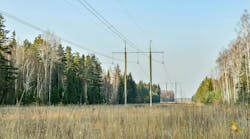Great Lakes Energy of Boyne City, Michigan, has selected StakeOut mobile field design client to streamline work flow as well as synchronize all office, customer and engineering data.
Great Lakes Energy is Michigan’s largest electric cooperative, and one of the largest in the country, serving 125,000 members in more than 26 counties across the western half of the Lower Peninsula.
Great Lakes system engineer Gus Paz said that installing the client-server based StakeOut 7.5 was part of a substantial technology upgrade that saw a transition from paper to digital after commissioning a Milsoft WindMilMap GIS.
“Our plans originally called for acquiring a GIS system and we saw PC-based staking packages as a natural and necessary extension. Until now, all of our field design technicians manually sketched drawings and calculated units. Soon they will be designing new job sketches, adding construction units, generating cost estimates and producing staking sheets on a notebook PC. And with built-in interfaces, that same data can populate our digital maps and update our Daffron CIS (Customer Information System).”
StakeOut is field staking software that tracks work through carefully defined processes from initiation to close out, making status updates available throughout the utility. The software integrates with most CIS, Accounting and GIS packages using the NRECA’s MultiSpeak Standard. Work done in the field and posted to a GIS automatically updates the utility’s system maps in near real-time. Personnel throughout the enterprise have access to the most recent information.
The decision to go with StakeOut, according to Paz, was based on a selection criteria developed by Great Lakes when it began evaluating products.
“Obviously, the software had to interface with existing systems, but a primary concern was that it had to be user-friendly. It needed tools to calculate design attributes such as loading and sizing transformers and wires. There also had to be automatic connectivity checks to make sure the system was connected properly. When we compared software packages against these criteria, StakeOut came out on top.”
Even before the cutover to advanced mapping and staking, Paz said that Great Lakes Energy understood the productivity gains and improved customer service that could be achieved simply by the reductions in data entry.
“We won’t have to re-draw maps into the mapping system and both the office and field will be able to share data without a lot of re-entry. Saving all that time will allow us to pay for the StakeOut system in less than three years.”

